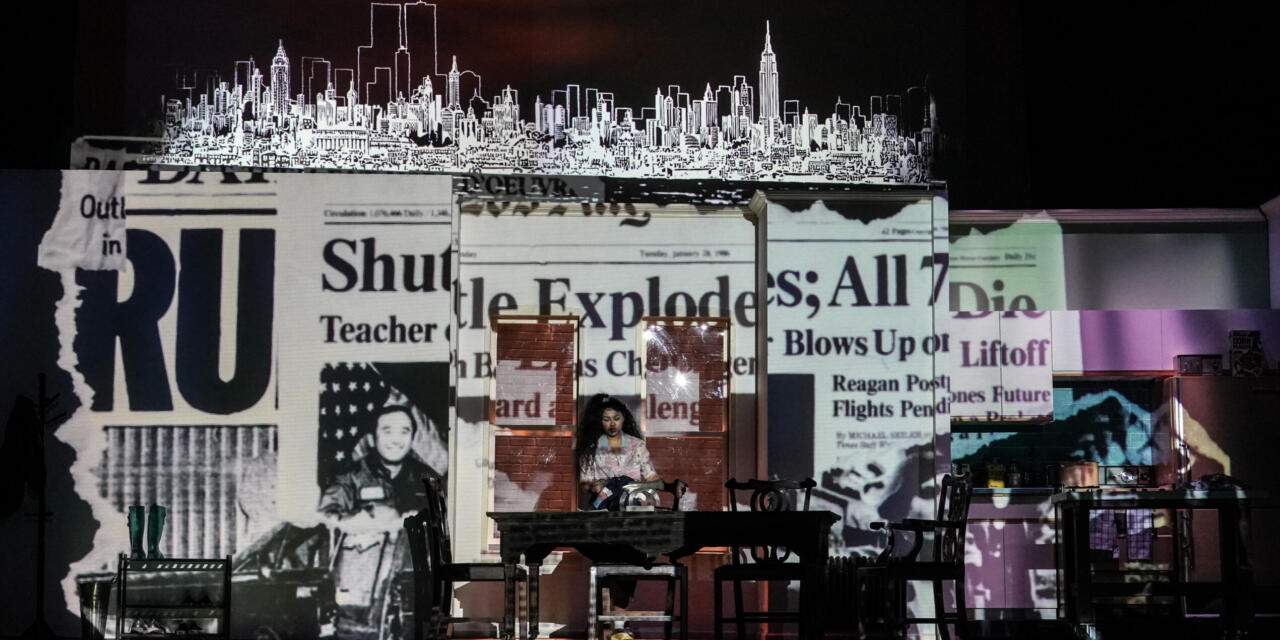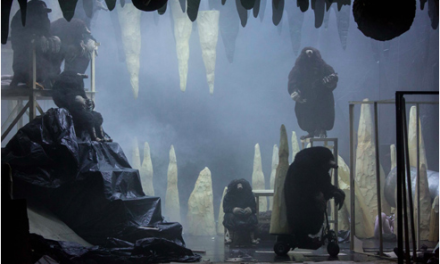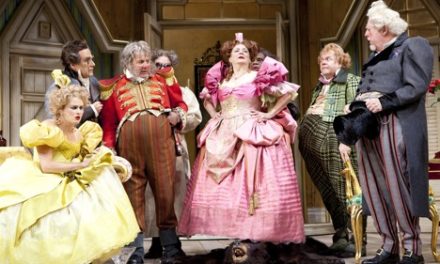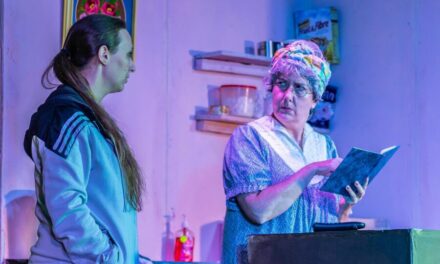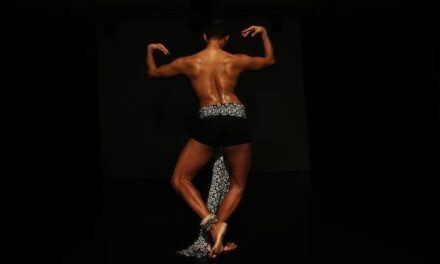TRACES is a new devised documentary theater piece presented by the investigative theatre group What Will the Neighbors Say? and commissioned by CUNY Queens College in Queens, NY. Researched and written by CUNY students and directed by Neighbors’ Co-Artistic Directors James Clements and Sam Hood Adrain, TRACES follows the complex, interweaving lives lived in one apartment in Queens, focusing on the stories of the immigrant residents who have dwelled there during the great pandemics that swept the United States – Spanish Flu, polio, HIV/AIDS and COVID-19. The production had its world premiere March 9-19th, 2023 as part of CUNY Queens College’s Mainstage theatrical season, and represents the culmination of the Neighbors’ three years as Artists-in-Residence at the College.
I spoke with co-creators James Clements and Sam Hood Adrain about the show’s background, creative journey, and themes, as well as the process of developing topical new work in partnership with CUNY students and members of the Queens community.
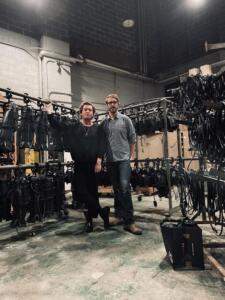
James and Sam. Co-Artistic Directors, What Will the Neighbors Say?
How did TRACES come into being, and what was the incentive behind creating it?
The name TRACES actually initially came from the early pandemic term “contact tracing.” It quickly grew to mean more: the traces we leave on our homes, each other, and our city, but it all came from the thinking that everyone and everything you come in contact with is now connected to your health and well-being. We started as Artists-in-Residence at CUNY Queens College in January 2020. This meant being on the Adjunct Faculty and doing a show with students in 2021. Of course, eight weeks into our time there the pandemic hits and everything goes online. As we were sitting isolated from each other and our communities, we started to ideate on how we could talk about what was going on without just writing a play about COVID. It was so new and so scary we knew that we needed to find a way to talk about what we were feeling but not simply create a piece about an ongoing pandemic. As we were teaching our Zoom classes and thinking about the world around us an idea began to clarify. Queens is the country’s most diverse county; it was the pandemic’s epicenter at the time, and we already had roots with folx in the community. What if we created a show that talked about pandemic life in Queens through the last hundred years as a way to examine the collective experience and trauma we were feeling in 2020? Given our history with documentary and source-based theater, we felt it was well within our wheelhouse to find the stories, sources, and oral histories to give the piece the authenticity and heart we were looking for. Three years later – after two courses, multiple workshops, a lengthy devising process, hundreds of research hours and two consecutive NEA awards – here we are!
Describe your journey of co-creating the show with CUNY Queens students: how were scenes devised and developed, and what did the students bring to the process? Were there any unexpected triumphs or challenges you faced?
We truly cannot say enough good things about the students, faculty, and staff at Queens College! The students have been the main driver of this piece, from research to writing to performing and production, they have been working tirelessly since the Fall semester. In the Fall of 2022 we taught a class called “Traces: Page to Stage” in which students did primary source research at the library archives on campus, conducted interviews, and ultimately each wrote the first draft of a scene inspired by all this work as their final project, set in either 1918 (Spanish Flu), 1952 (Polio), 1986 (HIV/AIDS) or 2020 (COVID). From there, we picked four of the scenes (one from each of the eras we were hoping to examine) and compiled them together as the initial script. Then it was time to cast, and we knew that we wanted a cast of actors who reflected the diversity of the borough around us, with special emphasis on immigrants and first-generation folx. Out of over thirty students who auditioned we chose twelve to make up our devising ensemble. Starting in the beginning of February, we would meet every night to rehearse and create the piece. Using that initial script draft as the jumping-off point, we led this cohort of actors through devising and ensemble-building exercises to personalize and specify each scene. Some scenes merely got tweaked while others got complete overhauls, but either way, our goal was to create the space for these students to discuss what mattered to them within the historical context of each era. From queer relationships to chosen families to immigrant soup-making, they are the ones who drove the thematic discussions in this play and we could not be more proud of their work! Ultimately this show was created by eleven fall semester students and a devising group of twelve, some of whom were also in the class, facilitated and directed by us. They are the writers of this play – we wrote maybe five lines total to bridge some dramaturgical gaps, but otherwise, every word you hear on stage came from them. We’d also like to give a huge shout-out to our theatrical designers who listened to what mattered to these students and highlighted that in every aspect of their designs.
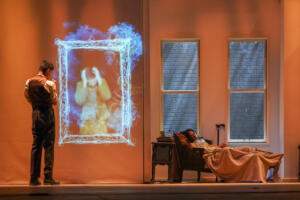
The devisors and cast of TRACES at CUNY Queens College. PC: Dominick Totino.
Setting out to create a documentary piece around historical pandemics and their impact on specific communities, what were some of your key findings? Did common themes naturally emerge from your research, or did you have to work more deliberately to connect the stories within the play?
There were two phases to this project in terms of research and each came with its own set of fascinating questions and discoveries.
For the grassroots archival research that we did over the course of 2022, we were most interested to see the growth of Queens throughout the 20th century. It was quite literally farmland until the 1950s and there are stunning pictures at the Queens Historical Society showing farms, fields, and water wells with the skyline and Empire State Building just three miles in the background. Also, the newspaper clippings from the height of the HIV/AIDS epidemic were harrowing, especially those focusing on school-aged kids and their so-called “risk of exposure” to the disease in school, and the protests around that thinking.
From the work the students did, they were much more interested in the recent history of Swine Flu and COVID. They really wanted to find ways to talk about what they have gone through since 2020 in the piece and were particularly focused on mental health and depression. There was a lot of joy and love but also a lot of struggle and confusion as they talked to family and friends about COVID and the shutdowns. It was a reminder how difficult the past three years have been on all of us, and also a reminder of our resilience and survival.
Ultimately we had so much research and thematic material that we had to pare back and decide where to focus our energy. As a group, led as always by the students, we came up with four core questions that ended up guiding our work:
- Do public health crises change the way we view the worth of a human life?
- How have different generations approached the topic of public health crises?
- For better or worse, how do communities survive during times of crisis?
- How are those targeted as a result of their identity most affected by systems and institutions when it comes to public health?
TRACES has a very strong and specific sense of place, from its core setting in a Queens apartment to the local news reports and interviews interspersed throughout. How did you work with the Queens community to build that throughline and connect the piece to local history? Were there any particular stories or anecdotes that stood out?
Over our three years in residence with the College, we were always gathering data, collecting information, sources, stories, and experiences. Through our courses at the College, the students conducted interviews – with grandparents, educators, deli owners, and undocumented folks – to gain insights into their experiences of Queens, of pandemics, of American life. We also worked with our fabulous community partners Queens Memory Project, the Queens Public Library, and the Queens Historical Society, in their archives, collecting newspaper clippings, reading letters, and exploring official documents relating to Queens and Queens’ history. So, as we began the devising process, we had a really rich, full archive (of historical sources, interviews, images, news reports, anecdotes) with which to build. Two really come to mind for us thinking back now. First was an incredible interview by Amanda Aulet, an Italian/Puerto Rican-American student who interviewed her two elderly great aunts, who were absolutely hilarious. Quintessential New Yorkers. The interview ran at about an hour – more than four times the assigned length. And they were just brilliant – again, in a way, they felt like all of our aunties, whether we were from Scotland or Nigeria or Hong Kong. And then, another one that stays with us: another brilliant student, Josiah Rodriguez, whose father was driving vans with essential supplies during the worst of the COVID pandemic, putting himself at huge risk, when Queens was really being decimated. It was tough to hear about his experience, but felt cathartic and healing in an opposite, but equally profound, way to Amanda’s. Another way that we really tried to connect the stories was through the literal “traces” different generations of characters left behind in the apartment, depicted beautifully by our video designer Cosette Pin on a set by Jessica Alexandra Cancino, as well as featuring verbatim text in our soundscape, designed by the wonderful Liam Bellman-Sharpe (all three of these designers are immigrants, too). We couldn’t have been luckier with our collaborators, with our students, and with the generosity of the people of Queens.
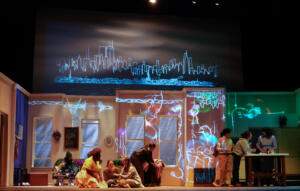
The devisors and cast of TRACES at CUNY Queens College. PC: Dominick Totino.
In each vignette, the show’s characters often face several broader socio-political issues (race and immigrant status, gender and sexuality, isolation, trauma, displacement, etc) in addition to interpersonal conflicts and the pandemics themselves. How did the personal and political overlap for the piece’s collaborators, and how did they find their way into the script?
We love this question. With our twelve actors, we actually began our devising process by creating community agreements for the room (as we always do), so a fair amount of information about each collaborator and their needs was shared through that already. James’ partner (an educator and director) had introduced us to the Wheel of Privilege and Power, a tool that allows for clear, unbiased discussions around positionality. So we worked with our actors to explore our various positionalities, and ended up each creating defining sentences for ourselves that clearly explained who we are in the world, which we then shared with the group. From there, we spoke to each of the actors individually about what role made the most sense for them – combining our casting ideas, their casting ideas and what development each scene would need to sit right in their bodies. From there, we divided the cast into the individual scenes, and began the intensive re-writing process described above. From there, once it was cast, they just took it and ran with it, really. Moments of their mother tongue dropped in, familial and cultural shorthands appeared, pop culture references, food, you name it – the students really drove that process. We continued making script edits pretty much until tech. The goal, always, was to create a piece that felt authentic, personal, and specific to them. The piece uses a historical framework to tell these folks’ own stories, in a sense.
What do you hope the show’s impact will be?
We hope that the folks who see it – whether they are from Queens, are immigrants here, or are simply human beings moving through such a difficult and uncertain time for our world – see their own lives and experiences on stage, and feel themselves in community with one another through that. This is a piece that is both hyper-specific, and totally universal all at once – if you are from Flushing, different things will resonate than if you are from, say, Paris. But, there are certain things that everyone can relate to – family fracturing, isolation, mental health, sibling conflict – regardless of their lived experiences. We also hope we encourage folks to consider the challenges of immigrant life and recognize and respect the richness and variety immigrants bring to the United States. So, two principal impacts – for people to feel in community with one another, and to advocate for immigrant communities in this country. We hope we achieved that with TRACES.
This post was written by the author in their personal capacity.The opinions expressed in this article are the author’s own and do not reflect the view of The Theatre Times, their staff or collaborators.
This post was written by Emily Cordes.
The views expressed here belong to the author and do not necessarily reflect our views and opinions.

